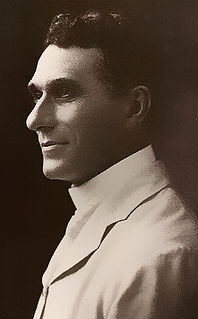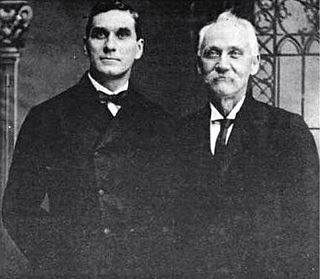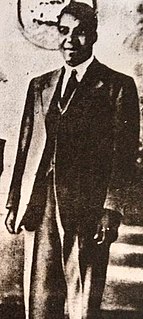Zionist Churches are a group of Christian denominations that derive from the Christian Catholic Apostolic Church, which was founded by John Alexander Dowie in Zion, Illinois, at the end of the 19th century. Missionaries from the church came to South Africa in 1904 and among their first recruits were Pieter Louis le Roux and Daniel Nkonyane of Wakkerstroom who continued to evangelize after the Zionist missionaries left in 1908. [1]
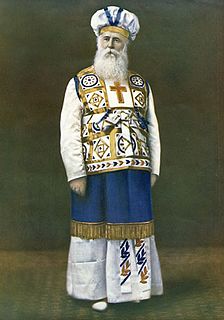
John Alexander Dowie was a Scottish evangelist and faith healer who ministered in Australia and the United States. He founded the city of Zion, Illinois, and the Christian Catholic Apostolic Church.

Zion is a city in Lake County, Illinois, United States. The population was 22,866 at the 2000 census, and had grown to 24,413 as of 2010.

South Africa, officially the Republic of South Africa (RSA), is the southernmost country in Africa. It is bounded to the south by 2,798 kilometres (1,739 mi) of coastline of Southern Africa stretching along the South Atlantic and Indian Oceans; to the north by the neighbouring countries of Namibia, Botswana, and Zimbabwe; and to the east and northeast by Mozambique and Eswatini (Swaziland); and it surrounds the enclaved country of Lesotho. South Africa is the largest country in Southern Africa and the 25th-largest country in the world by land area and, with over 57 million people, is the world's 24th-most populous nation. It is the southernmost country on the mainland of the Old World or the Eastern Hemisphere. About 80 percent of South Africans are of Sub-Saharan African ancestry, divided among a variety of ethnic groups speaking different African languages, nine of which have official status. The remaining population consists of Africa's largest communities of European (White), Asian (Indian), and multiracial (Coloured) ancestry.
Contents
The Zionist Churches proliferated throughout southern Africa, and became African Independent Churches; research in 1996 suggested that 40% of all black South Africans belonged to a Zionist church. [2]

Southern Africa is the southernmost region of the African continent, variably defined by geography or geopolitics, and including several countries. The term southern Africa or Southern Africa, generally includes Angola, Botswana, Eswatini (Swaziland), Lesotho, Malawi, Mozambique, Namibia, South Africa, Zambia, and Zimbabwe, though Angola may be included in Central Africa and Malawi, Mozambique, Zambia and Zimbabwe in East Africa. From a political perspective the region is said to be unipolar with South Africa as a first regional power.
The church is unrelated to the Jewish political movement of Zionism.

Zionism is the national movement of the Jewish people that supports the re-establishment of a Jewish homeland in the territory defined as the historic Land of Israel. Modern Zionism emerged in the late 19th century in Central and Eastern Europe as a national revival movement, both in reaction to newer waves of antisemitism and as an imitative response to other nationalist movements. Soon after this, most leaders of the movement associated the main goal with creating the desired state in Palestine, then an area controlled by the Ottoman Empire.
The Old Cornerstone Apostolic Church in Zion of South Africa. Under Archbishop Mawethu Anthwell Zionist beliefs grew out of late-nineteenth and early-twentieth religious missions to southern Africa. In particular the churches owe their origins to the Christian Catholic Apostolic Church of John Alexander Dowie, based in Zion, Illinois in the United States.

The United States of America (USA), commonly known as the United States or America, is a country composed of 50 states, a federal district, five major self-governing territories, and various possessions. At 3.8 million square miles, the United States is the world's third or fourth largest country by total area and is slightly smaller than the entire continent of Europe's 3.9 million square miles. With a population of over 327 million people, the U.S. is the third most populous country. The capital is Washington, D.C., and the largest city by population is New York City. Forty-eight states and the capital's federal district are contiguous in North America between Canada and Mexico. The State of Alaska is in the northwest corner of North America, bordered by Canada to the east and across the Bering Strait from Russia to the west. The State of Hawaii is an archipelago in the mid-Pacific Ocean. The U.S. territories are scattered about the Pacific Ocean and the Caribbean Sea, stretching across nine official time zones. The extremely diverse geography, climate, and wildlife of the United States make it one of the world's 17 megadiverse countries.
The arrival of Dowie's emissary, Daniel Bryant, in 1904 led to the formation of a formal Zionist church. Prior to this, two concentrations of sympathizers, energized by Dowie's publication, Leaves of Healing, had existed on the Witwatersrand and at Wakkerstroom in the Transvaal. This initial Zionist church did not flourish for long due to Dowie's disgracing in America. In 1908, however, the arrival of the former Zionist-turned-Pentecostal John G Lake led to most former Zionists embracing the newly formed Apostolic Faith Mission. The vast majority of all Zionist sects derive from secessions from the Apostolic Faith Mission, which fused Pentecostalism with Dowie's Zionist ideas about faith healing.

The Witwatersrand is a 56-kilometre-long (35 mi), north-facing scarp in South Africa. It consists of a hard, erosion-resistant quartzite metamorphic rock, over which several north-flowing rivers form waterfalls, which account for the name Witwatersrand, meaning "ridge of white waters" in Afrikaans. This east-west-running scarp can be traced with only one short gap, from Bedfordview in the east, through Johannesburg and Roodepoort, to Krugersdorp in the west.

Wakkerstroom,, is the second oldest town in Mpumalanga province, South Africa. The town is on the KwaZulu-Natal border, 27 km east of Volksrust and 56 km south-east of Amersfoort.
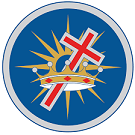
The Apostolic Faith Mission of South Africa (AFM) is a classical Pentecostal Christian denomination in South Africa. With 1.2 million adherents, it is South Africa's largest Pentecostal church and the fifth largest religious grouping in South Africa representing 7.6 percent of the population. Dr. Isak Burger has led the AFM as president since 1996 when the white and black branches of the church were united. It is a member of the Apostolic Faith Mission International, a fellowship of 23 AFM national churches. It is also a member of the South African Council of Churches.
Several key African-led secessions from the AFM led to the explosion of Zionist sects in the 1910s and 1920s. The first was led by Daniel Nkonyane, who was Le Roux's deputy in Wakkerstroom. In 1908 Le Roux became an important AFM official and spent most of his time in the Johannesburg headquarters thereafter. In his absence Nkonyane took effective control and insisted on several key changes to doctrine. Perhaps most importantly, he stressed the need for his followers to propitiate their ancestors—a practice abhorred by the AFM and most Christian denominations. Nkonyane maintained that “Whoever forsakes his ancestors is also forsaken by his ancestors and he becomes an easy prey for disease.” [3] Secondly, he insisted that the form of ornate religious dress worn by Dowie, including robes, staffs, and other paraphernalia, should be used in his congregation. [4] In 1910 Nkonyane's defiance versus the AFM and local authorities led to his expulsion from Wakkerstroom. Eventually, he and about two-thirds of the Wakkerstroom congregation pooled their resources and obtained freehold property in Charlestown, Natal, where they built the first South African "Zion". Many dozens of offshoots from Nkonyane's church formed small Zionist churches, especially in Swaziland and Natal. [5]
The next significant secession from the AFM was by a little-known member, Isaiah Shembe. Shembe was a member of the AFM for only a year in the Orange Free State, when the Ethiopian church that he preached for joined the AFM en masse. [6] In 1911 Shembe left the Free State and moved to Natal, where he used the AFM's faith healing techniques to build up a following across the province. Harnessing the meager resources of his followers, he formed the Narazeth Baptist Church and purchased freehold land at Ekuphakameni, the second South African "Zion". Shembe's Nazarite church was to become the largest Zionist congregation until eclipsed by the Zion Christian Church in the 1950s. Shembe's church was distinct from most other Zionist sects in that he insisted that he was a prophet sent directly from God to the Zulu nation. Most other Zionists were distinctly non-ethnic in outlook. [7]
Edward Lion's Zion Apostolic Faith Mission (ZAFM) was also a critical early Zionist sect. Lion, an early Zionist convert, was appointed AFM leader in Basotholand in 1912. Prior to this Lion had received extensive training as a faith healer by John G Lake. [8] After obtaining land from a sympathetic chief, Lion began to build his own Zion in Kolonyama, Basotholand (now known as Lesotho), and formed ZAFM in 1917. Still under the AFM umbrella, he moved his followers to Kolonyama in 1920, and had an increasingly fractious relationship with the AFM until he was expelled in 1923. A number of doctrinal innovations, including sexual confession, brought him negative attention from the authorities, and Lion was eventually jailed for rape and subsequently expelled from Basotholand in 1927. [9] Following his expulsion, Lion raised funds by garnishing his congregations' wages and bought several pieces of freehold land in the Transvaal that he attempted to turn into another "Zion". [10] Lion's organization failed to grow significantly after his expulsion. Among its more important offshoots was the Zion Christian Church, whose founder, Engenas Lekganyane, was Lion's Transvaal leader in the early 1920s.


